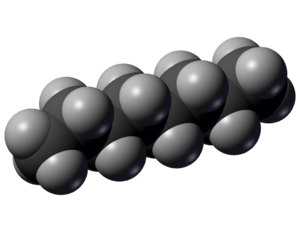Organic molecule
Organic molecules are molecules which are made of carbon and other elements. At least one of the atoms in the molecule must be carbon, they usually involve hydrogen and oxygen, and they can also involve nitrogen, sulfur, and phosphorous. Hydrocarbons, like methane, ethane, and octane are all organic molecules, but so are carbohydrates.
Generally speaking, organic molecules come from living or formally living organisms, but not always. Dead and decaying biomass creates organic molecules that can be used as a fuel. Much of the world's primary energy comes from fossil fuels, which are made up of mostly organic molecules. When burning these organic molecules (combustion combines the carbon with oxygen from the atmosphere) carbon dioxide is produced.
Organic chemistry is a vast field that takes many years of study to fully understand; to get a start, please see UC Davis's chem wiki.
References
- ↑ "N-octane-spaceFilling" by Karlhahn - Own work. Licensed under Public Domain via Wikimedia Commons - http://commons.wikimedia.org/wiki/File:N-octane-spaceFilling.png#mediaviewer/File:N-octane-spaceFilling.png


